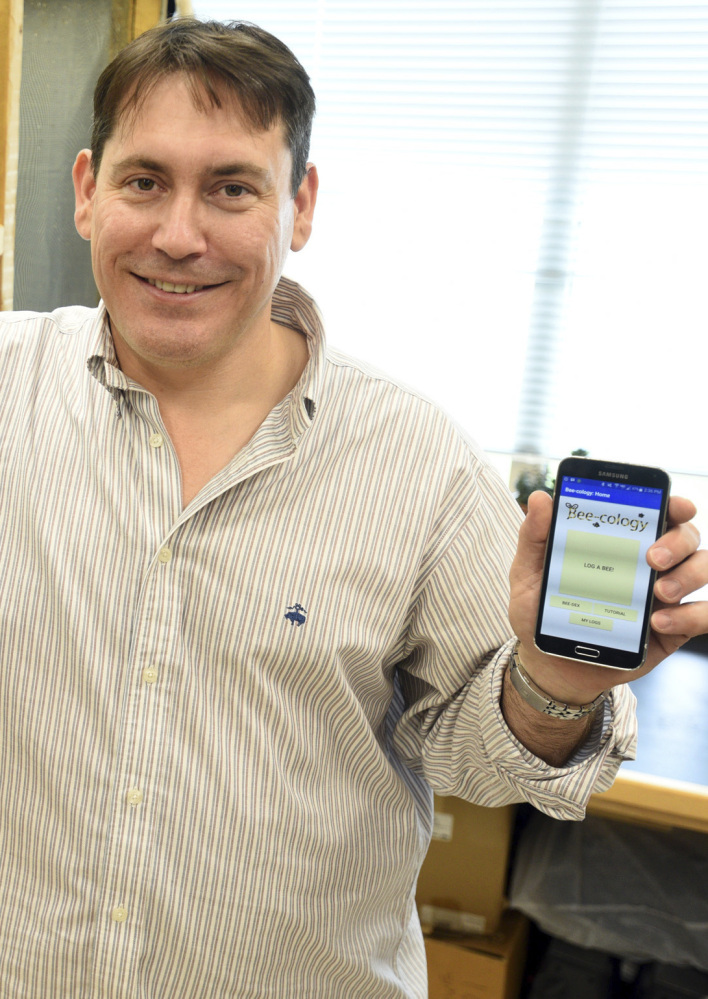WORCESTER, Mass. — Want to know what kind of bumblebee you see?
There’s an app for that.
A Worcester Polytechnic Institute professor hopes the app will create enough “buzz” to save the insects by documenting the relationship between specific bees and flowers.
“The app collects data on individual species of bee and flowers and allows us to figure out what the individual needs of the species are … so people can make changes to their yard, learn what flowers to plant, and tell us how do we conserve lands to increase bee diversity,” said Robert J. Gegear, assistant professor of biology and biotechnology at WPI and director of the New England Bee-cology project. “Our app is showing us what the relationships are between bees and flowers. But we need a lot of data, which is why we want to crowdsource it.”
REPORTING THE DATA
The Bee-cology smartphone app and interactive website contain software that enables users to take a video of a bumblebee, accurately identify the species as one of 11 species native to Massachusetts, identify the plant species the insect is visiting, and then send the information to a public database. The database records such information as the species of bumblebee and the species of flower it is visiting, and records the location, date and time of the bee-plant interaction.
The data can then be compared with historical data dating to the late 19th century to determine how bee habitat and populations have changed. The app is available for Android users, and the website – which is in development – can accommodate iPhone users. The iPhone version of the app is soon to follow.
Gegear said the app will help to document the relationship among bumblebees and specific flowers on which they depend for food.
It is a critical time to understand these relationships.
Gegear has been studying bumblebees for more than 20 years (and said he has been stung 20 to 30 times during that time) and is witnessing what he called a “rapid decline” in many native bumblebee species’ populations because of factors such as disease, pesticides, climate change and habitat modification.
In fact, the U.S. Fish and Wildlife Service recently listed the first bumblebee as an endangered species. More than half the bumblebee species in Massachusetts are in serious trouble, Gegear said.
DECLINE IN NATIVE POLLINATORS
While most of the attention on bee decline focuses on the non-native honeybee because of its importance in crop pollination, a decline in native bumblebees and other native pollinators can have a devastating effect on the diversity of local ecosystems, Gegear said.
Bumblebees and other native pollinators are considered “keystone species” whose presence has cascading positive effects on the survival of other species. The bees pollinate native plants that produce fruit and seeds that feed other wildlife. The native plants also provide habitat and nesting sites.
But the relationship between specific species of bees and species of plants is not well documented. For instance, do certain native bees depend on certain species of flowers? Do changing habitats impact some species more than others? Have exotic plants helped or harmed populations of native bees?
MAKING AN INVENTORY
Gegear hopes that the app will help answer these and other questions.
“We can take an inventory of bees, and once we compile that data we can use artificial intelligence techniques and machine learning techniques to find patterns in the data,” explained Carolina Ruiz, associate professor of computer science and bioinformatics and computational biology at WPI, who oversaw the development of the app. “We can see trends over time, species moving in the region … in terms of quantities of the bees, we want to see how they are going down over time.”
But Gegear needs a lot of help.
So he is going out and giving talks to local environmental groups to try to promote the use of the app. The goal is to have a team of volunteers per county who can go out once a week and look for bees. Meanwhile, casual users are invited to shoot video of bees in their backyard gardens.
“We need the help of the general public to save our ecosystem and protect our native bees to keep our ecosystem healthy,” Gegear said.
Send questions/comments to the editors.



Success. Please wait for the page to reload. If the page does not reload within 5 seconds, please refresh the page.
Enter your email and password to access comments.
Hi, to comment on stories you must . This profile is in addition to your subscription and website login.
Already have a commenting profile? .
Invalid username/password.
Please check your email to confirm and complete your registration.
Only subscribers are eligible to post comments. Please subscribe or login first for digital access. Here’s why.
Use the form below to reset your password. When you've submitted your account email, we will send an email with a reset code.